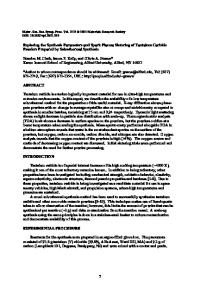Synthesis of Bulk Quasicrystals by Spark Plasma Sintering
- PDF / 458,900 Bytes
- 6 Pages / 612 x 792 pts (letter) Page_size
- 90 Downloads / 390 Views
Synthesis of Bulk Quasicrystals by Spark Plasma Sintering E. Fleury1, J.H. Lee2, S.H. Kim1, G.S. Song1, J.S. Kim3, W.T. Kim4 and D.H. Kim1 1 Yonsei University, Center for Noncrystalline Materials, Department of Metallurgical Engineering, Seoul, Korea 2 Asan Medical Center, Department of Biomedical Engineering, Seoul, Korea 3 Ulsan University, Department of Materials Science and Engineering, Ulsan, Korea 4 Chongju University, Department of Physics, Chongju, Korea ABSTRACT Spark plasma sintering method was applied to Al-Cu-Fe and Al-Si-Cu-Fe gas-atomized powders to prepare almost pore-free cylindrical specimens with icosahedral and 1/1 cubic approximant phases, respectively. This investigation has revealed that a high density could be obtained despite the short period and low temperature imposed during spark plasma sintering. In comparison to hot press technique, these conditions are favorable since they limit the formation of secondary phases and avoid exaggerated grain growth. The Vickers microhardness and fracture toughness of these two alloy systems were found to be larger than those obtained from cast and hot pressed samples, which could be attributed to a strong bonding between powder particles and the small-grained microstructure of the bulk SPS quasicrystalline specimens. INTRODUCTION Although discovered two decades ago, the preparation and determination of physical properties of quasicrystals are still the focus of numerous investigations [1]. Owing to their stability, quasicrystals can be prepared either directly from solidification or via powder metallurgy route. The preparation of specimens from conventional cast technique often introduces voids and cracks that are not desirable for the determination of physical and mechanical properties. Hot uniaxial or isostatic pressing techniques are well-established processes for the compaction of powder metallurgical materials below their melting point. These techniques have been successfully applied for the preparation of bulk quasicrystals with low porosity content [2,3]. Recently, the spark plasma sintering (SPS) process has received much attention as a method of preparing dense metallic ingots and engineering ceramics [4]. The SPS process is an electrical sintering technique, which applies a ON-OFF DC pulse voltage. In addition to sintering mechanisms such as the Joule heat generated by the powder supply and the plastic flow of the material under the application of the pressure, the SPS process utilizes the self-heating action caused by spark discharges between powder particles in the initial stage of the pulse energy. By the generation of the spark plasma, the powder particle surface is more easily activated than in conventional electrical sintering process and materials transfer is promoted, which allows a rapid sintering at a low average temperature. In the present work, we made an attempt to prepare Al-Cu-Fe and Al-Si-Cu-Fe bulk
K2.1.1
alloys using spark plasma sintering. Evolution of the microstructures was investigated during SPS processing, and mechanic
Data Loading...











